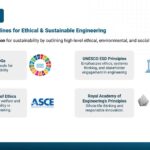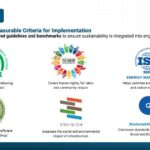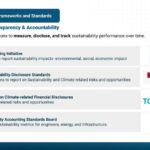First, let’s define terms.
“Principles are values. They are guiding beliefs. Standards are very specific and measurable,” Gaurav Awasthi, a sustainability and climate change advisor at Tata Consultancy Services in Mississauga, Ontario (Canada) says.
Mr. Awasthi made his remarks in a presentation clarifying the murky world of sustainability principles, standards, and reporting frameworks. His talk, aimed at early career engineers and students in the Engineering for Change Fellowship Program, emphasized that aligning projects within the reporting frameworks can unlock better financing, regulatory compliance, and market credibility.
This is what engineers should know about sustainability principles and standards, and what to expect from the most widely used reporting frameworks.
From Principles to Standards
The first takeaway is that principles, such as the UN’s Sustainable Development Goals (SDGs) and UNESCO’s ethical engineering guidelines, provide high-level guidance. While measurable standards such as ISO 14001 (environmental management) or LEED (green buildings) are what ground sustainability commitments in practicality.
Principles set the vision, while standards offer concrete benchmarks such as carbon emissions per ton of steel, for example. Standards enable cross-industry comparisons. Reporting frameworks are how companies track and demonstrate their compliance with standards.
Take a look at the Global Reporting Initiative (GRI). This is a gold standard for impact standards, used by 78 percent of the 250 biggest companies in the world. It is the standard for sustainability reporting for all kinds of firms. Mr. Awasthi says.
“Engineers, when they design and when they implement, they should keep the GRI standards in mind. It talks about supply chain due diligence. It talks about forced labor and child labor. It talks about anti-bribery, anti-corruption, even policy related to lobbying with governments. So, all of these things across social, economic, human rights, environmental pillars, you will see in GRI standards,” Mr. Awasthi says.
- Image: Gaurav Awasthi / E4C
- Image: Gaurav Awasthi / E4C
- Image: Gaurav Awasthi / E4C
Reporting Is Increasingly Mandatory
Regulatory shifts are forcing companies to adopt these standards. The compliance for reporting under EU’s Corporate Sustainability Reporting Directive (CSRD), Canada’s upcoming sustainability mandates, Australian reporting standards etc. is coming into force very swiftly. That said, GRI remains the most popular framework for sustainability reporting globally. Many companies use GRI voluntarily to demonstrate their commitment to sustainability and transparency, Mr. Awasthi says.
Even startups should proactively engage. Investors increasingly rely on Environmental, Social and Governance (ESG) ratings from agencies like MSCI or S&P Global, which use standardized disclosures to evaluate sustainability and climate related risks to the investee firms.
Standards normalize information
A key benefit of compliance with standards and using GRI and other frameworks to report is they can normalize information across organizations that may be very different. In other words, they allow for accurate comparisons of similar disclosures across various firms.
One example Mr. Awasthi offers is in steel production. Intensity level disclosures of carbon dioxide emitted per ton of steel produced allow for comparisons between steel companies anywhere in the world.
“There are lot of ways by which this standardization can work,” Mr. Awasthi says.
When an attendee asked about data harmonization across borders, Mr. Awasthi acknowledged the complexity but pointed to digital tools like XBRL, which tag sustainability data for comparability.
Materiality: A Core Challenge
A key hurdle is conducting materiality assessments, which identify the sustainability topics that matter most to a project or business. Mr. Awasthi outlined two approaches:
Impact materiality (GRI’s focus): How a company affects the environment and society.
Financial materiality (IFRS’s focus): How climate risks or social unrest could disrupt revenue.
For example, a bank financing an oil company must assess not just the project’s environmental harm but also whether demand for oil will persist amid the energy transition.
Advice for Engineers and Founders
Mr. Awasthi’s advice is to start with free resources. GRI’s standards are publicly available and are a great starting point, while IFRS is more around sustainability and climate related financial risks and opportunities, and SASB offer sector-specific guidance.
Align early: Even pilot projects should consider relevant standards (for example: ISO 14001 for waste management).
Leverage reporting: Transparent disclosures can attract investors. Companies get better loan rates if they’re LEED-certified, for example.
No longer an option
A final takeaway may be that sustainability is no longer optional. In their daily work, engineers need to align with standards. And for innovators in climate tech and sustainable development, reporting within these frameworks ensures compliance and offers a competitive edge.
For more insight into sustainability and climate change, see Mr. Awasthi’s substack, or find him on LinkedIn.




